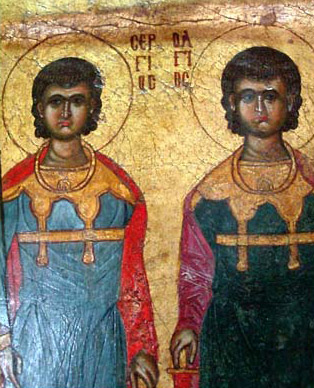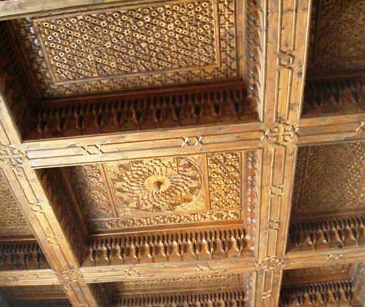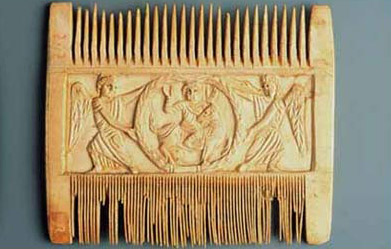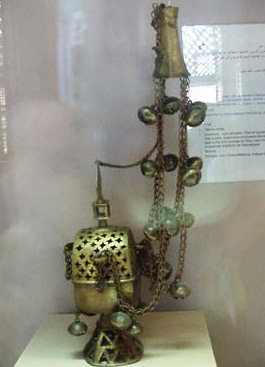The Coptic Museum
by Seif Kamel

The Coptic Museum in Cairo has been closed for some time for remodeling, but we are now celebrating its recent reopening, a welcome addition to Old Coptic Cairo. It is located in the heart of Coptic Cairo.
Christianity has a long history in Egypt, and there continues to be a significant population of Christians in Egypt today. Besides the truly Egyptian heritage of Coptic Christians, there are also Roman Catholics, as well as a number of Protestant sects. Christianity spread in Egypt during the 2nd century in Egypt, just after and indeed during the Roman pagan period, and it became the dominant religion in Egypt up until the Arab invasion in 641 AD.


Christian art, specific to the Coptics of Egypt, began to emerge around 300 AD. Though Christianity marked the end of the Pharaonic period in Egypt, and even though many traditions from that more ancient religion were carried over to become a part of not only the Christian faith in Egypt, but later even the Islamic faith, the art in form, style and content was very different from those earlier times.
We can identify principally three reasons that Egyptian art made such a radical change. First of all, art was no longer such an imperial effort of the ruling elite, formalized according to the dictates of a small minority. The second reason is that Christianity delivered a very different message than that of the former pagan religion, and the art indeed changed to deliver this message. Finally, the social origins of Coptic art is perhaps best characterized as folk art. While there were certainly some professional artists centered mostly in Alexandria, at first, most of the Christian artists were local folk who did the best with their undertaking as they could.
One interesting difference is that, by around 300 AD, three-dimensional art seems to have almost completely disappeared in Egypt, at least in the form of statuary. The last free standing sculptures in Egypt were those of Roman emperors, but the sculptures of the early Coptics, irregardless of the material used, were engaged, consisting more of an exaggerated raised relief.

They usually faced the viewer directly, but they could also be half turned to one side. Over the centuries, these figures became flatter and more like conventional relief. This shift from three-dimensional representations probably also affected two-dimensional art. In traditional Pharaonic art, figures were most frequently represented in a combination of profile and frontal views, but Coptic art abandoned this old formula and turned the figure around to face the viewer. It is worth noting that much of this sculpture was originally coated with painted plaster which would have shown many details that are now gone.
The most striking stylistic feature of Coptic figurative representation are the exaggerated rounded or oval eyes, under relatively thick eyebrows, and the contrapposto position (the weight of the body thrown onto one leg). Garments are often depicted with details of pleats and folds. The figures range from tall and slim to the short and thickset. Facial expressions usually span a narrow divide between non-committal to somber.

Yet, some influences remained. As Christianity arose, the old indigenous religion and that of the Greek educated ruling elite had not yet vanished. Even though the style and form may have changed, Coptic Christian art featured a substantial amount of episodes from Greek religious thought, particularly the sculpture of Ahnas and textiles. The use of such motifs in a Christian context is somewhat puzzling, and we can really give no definitive solution to this, other than the overlap which occurred between these two cultures. In fact, it would certainly seem that a number of pagan themes were de-paganized and recycled to convey messages in keeping with Christian values. It has been argued that such themes themselves may have become a symbol of the triumph of Christianity over paganism.

The largest collection of Coptic Christian artifacts in the world, with some 16,000 pieces, belongs to the Coptic Museum in Cairo. Indeed, this museum represents more than simply a collection of ancient Christian art. Perhaps no more so than for its western Christian visitors, it embodies the very instant when the old, pagan world collided with that of their modern Christian world. It is an eye-opener for many, as it documents this not altogether gradual but very significant moment in time.
The first exhibition of Coptic art was held in Cairo during the nineteenth century in the "Salle Copte" at the Boulaq Museum. In 1908 Marcus Simaika Pasha founded the Coptic Museum on behalf of the Coptic Church. He chose for its location a unique place in Old Coptic Cairo, within the walls of the great Fortress of Babylon and surrounded by Cairo's oldest churches. With the support of Patriarch Cyril V he purchased artifacts from churches, monasteries, houses and private collections.
The old, original wing of the museum is in itself a fine piece of architecture consisting of a series of large rooms, roofed over with ancient decorated wood and containing beautiful mashrabiya. Its walls are overlaid with fine slabs of marble, arches a and tiles. In 1931 the Egyptian government recognized the significance of the Coptic Museum and made it a state institution. Afterwards, the greater part of the magnificent Coptic collection in the Egyptian Antiquities Museum was transferred to the Coptic Museum in 1939.
Then, in 1947 a large New Wing with a style complimentary to the old one was opened It too had carved wooden ceilings as well as picturesque fountains. It was later renovated with modern methods of exhibition and reopened on March 8th, 1984. Only recently was it once again renovated.
The "General Catalogue of the Coptic Museum", an ongoing international project, was initiated in 1986 to compile an current catalogue of all the objects in the museum. The Museum's rich collection is arranged mostly according to media.
Stonework
The provenance of most Coptic textiles and minor works of art is usually unknown, but Coptic sculpture and wall paintings are better documented. The most important sites for these items are Abu Mina, Saqqara, Ahnas, Oxyrhynchos, Antinoe and Bawit. Nevertheless, many of the excavations that unearthed these items took place in the 19th century, and were therefore not as well documented as one might suppose. Furthermore, the re-use of older architectural elements, often from pharaonic monuments, makes exact dating of Coptic sculpture difficult.


The majority of the monuments from which this collection was taken are in ruins. Mostly, architectural carvings, separate from their original context, including niches, pediments, friezes, lintels, consoles, columns and capitals, make of this exhibit. All of it was originally painted.

During the 4th and 5th centuries pagan mythological scenes, such as Orpheus and Eurydice or Leda and the swan, continued to be depicted alongside Christian themes. The cross, supported by erotes or angels, is a central element of Coptic sculpture. Often, scenes of the christological cycle appear isolated, such as the Madonna and Child and the Holy Virgin with the saints. Scenes from the Old Testament are also frequently incorporated into sculpture. Examples include Daniel flanked by two lions or the Three Hebrews in the Fiery Furnace. On the other hand, at the monastic sites of Bawit and Saqqara there was a clear tendency towards geometric and floral architectural sculpture with niches and friezes. Also, aspects of daily life, such as the grape harvest or fishing in the marshes, are not uncommon in Coptic sculpture.

Corinthian, basket and composite capitals were developed in a rich variety of abstract styles, especially discernable in the basket capitals of the 6th century.
The Stelae of Terenuthis (Kom Abu-Bellou)
Basically a part of the Stonework collection, these objects are mostly limestone gravestones (or stelae) discovered at Terenuthis which was for the most part a Graeco-Roman pagan cemetery. Almost all of them fall into one of two categories. The first type have the figure depicted frontally and often flanked by two small jackal-like dogs representing Anubis, the lord of the necropolis, or Horus, the life-giving solar god as well as Anubis. A second type depicts a figure reclining on a kline and holding a cup in the right hand. Many of the stelae are framed by an architectural structure of two columns carrying a triangular Greek pediment. These items are essential to the understanding and evaluation of the origins of Coptic art.
Ivory and Bone Carvings

Alexandria was one of the principal markets for African ivory during the Greek Period of Egyptian history. By the Roman Period, Persia became more important for Indian Ivory, while bone, a much cheaper substitute, began to be widely used as well. The Coptic Museum's collection of ivory and bone carvings consists of wooden bridal caskets of engraved bone or ivory plaques with naked human figures and nymphs, pyxides, bone figurines representing schematized female figures with cylindrical bodies; bone spindle whorls; pots and other objects of daily use. Included in this collection is the famous 6th century ivory comb depicting the Raising of Lazarus and the Healing of the Blind.
Metalwork
Not surprisingly perhaps, considering Egypt's historic quest for rare metals, the Coptic museums collection of metalwork is a rich one, containing gold and silver, but also copper, bronze and iron. These pieces represent some of the oldest objects in the museum, dating from the 3rd to the 19th century. They come from monasteries, churches and towns, and may therefore be either religious objects or items intended for everyday use. The main group includes crosses, censers, lamps, bells, bible caskets, chandeliers, church and monastery keys, liturgical implements. Other items include household utensils, such as bowls, dishes, pans and cooking bots, while for women there are kohl boxes, necklaces, earrings and bracelets, and there are also medical instruments, weights and measures and agricultural implements. Many of these items are well executed and adorned using different techniques.

The majority of these objects are difficult to date, though a few, such as the famous Luxor silver treasure of Abraham, bishop of Hermonthis (c. 600) and some of the Bible caskets, which are inscribed with dates, or objects found with coins, can be securely dated.
Woodwork

Egypt lacks good quality wood for the most part, which has always made it a valuable commodity. During the Pharaonic Period find wood, and especially ebony, was imported from the south (Kush, or Nubia and Punt) and cedar from Lebanon and Syria. During the Roman and Byzantine Periods, Egypt was much less prosperous then in much of the Pharaonic Period. Therefore, one might expect that fine imported wood should have been used mainly in Alexandria, but it is known, however, that indigenous wood such as tamarisk, acacia, sycamore, lebbakh, jujube and willow were widely and skillfully used by Coptic carpenters, and that imported woods, such as box, cedar, ebony liquidambar, olive and pine were employed for fine and important works. The main centers of Coptic carpentry were Babylon (a section of Old Coptic Cairo), Antinoe, Bawit and Akhmin.
Many churches and monasteries were once adorned with elaborate sculptures in wood, consisting of lintels, doors, panels and friezes, decorated with saints, Nile themes, floral and animal ornaments, geometric patterns and scenes taken from the Old and New Testaments. Smaller items made of wood for daily life include toilette equipment, combs, caskets, toys spindles, stamp seals and musical instruments.
Woodwork, particularly screens, doors and panels of the 10th through the 14th centuries, reflects clearly the influence of Islamic Art.
The Coptic Museum houses three of the most important wood artifacts from the churches of Old Coptic Cairo. They are the door of the Church of Saint Barbara, the altar of the Church of Saints Sergius and Bacchus and the lintel from Al-Mo'allqa.

They are very valuable for the study of Coptic sculpture during the period between the 4th and 6th centuries.
Glass
Glass has, since its first use in Egypt, been a very important and prosperous industry in Egypt. Unlike wood, sand, lime and soda, the raw materials of glass, were abundantly available in Egypt. In the 1st Century BC, it was discovered that molten glass could be blown through a hollow tube, thus allowing it to be produced in quantities that made it available to the general public. Blown, engraved, opaque and millefiori glass have all been produced by Egyptian glassmakers. Literary sources revel that liturgical vessels in the early Coptic church were most frequently made of glass, rather than gold or silver.
The Coptic Museum maintains a small collection containing glass vessels, goblets, pots, candle holders, toilette bottles and lamps, mostly of opaque glass.
Ceramics and Terracotta

Pottery is a cheap material and a huge quantity of various wares have been unearthed in Egypt. The study of Coptic pottery in particular has progressed remarkably in the last three decades are so thanks to carefully recorded excavations at many sites. Of particular interest are those of Abu Mina, Kellia, Athribis, Naqlun, Antinoe and Esna.
Most are made of brown, red, orange, yellow, cream and pink clay, some coarse and some polished. The Coptic Museum houses a fine collection of pottery made for everyday use, including huge storage jars, amphorae and wine jars, cooking pots, spouted vessels, vases, jugs, bowls and dishes. There are also terracotta ampullae, lamps and figurines.
Many of the pieces on display have intricate designs and motifs of which animals are the most common, including hares, doves, fish, lions, gazelles and fantastic animals. Many human figures, mostly in the form of busts, were also painted on pottery, similar to some of those from Bawit.
Characteristic of Coptic terracotta are frog-shaped lamps and ampullae depicting Saint Menas standing between two kneeling camels. The Coptic Museum also exhibits some examples of Islamic glazed pottery from Al-Fustat.
Wall paintings
Almost all Coptic wall painting is monastic. They were never intended to be great works of art, but some of them, and in particular those at Bawit and Saqqara from the 6th and 7th century, show a relatively high standard. These murals were applied to mud-brick walls which had been plastered and white-washed. The only technique used for Coptic murals was tempera.

Those paintings from the Monastery of Saint Apollo at Bawit (in the Bahariya Oasis), dating between the 6th and 8th centuries, consist of figural scenes including episodes from the Old Testament, representations of Christ the Pantokrator and the Holy Virgin and Child, often flanked by apostles, figures of monks and saints, medallions depicting the virtues, floral and geometric dadoes, and even hunting scenes.
The murals of the Monastery of Saint Jeremias at Saqqara are more or less similar to those of Bawit. The figures are strictly frontal and usually distinctly separated from each other. The presence of Byzantine influence can be seen, but the wall paintings are nevertheless not without originality in some themes as well as in style.
Icons

Most of the icons in the Coptic Museum were acquired from Cairo's oldest churches. The majority of them are relatively modern, dating from the 18th and 19th centuries. They are, nevertheless, interesting for their themes, including scenes from the Old and New Testaments, the Holy Virgin, saints and martyrs, and especially soldier saints. Coptic churches, both ancient and modern, are always adorned with icons since they are used in the liturgy of the Coptic Church. Indeed, the older churches are perhaps a better venue for seeing the older icons than the Coptic Museum.
However, several icons stand out. One, for example, dating to the 18th century, depicts Ahrakas and Oghani, who wear masks in the forms of dog heads. They pear towards a fruit tree. Another depicts the Virgin and Child. He raises a crown with a cross, and is flanked by Saint Peter and Saint Paul. Another touching icon represents the Virgin Mary holding the Christ child, and dates to the eighteenth century. Many others depict various saints.
Epigraphy and Manuscripts

The manuscripts and documents of the museum date from the 4th through the 19th centuries, and are written in Greek, Coptic, Syriac, Old Nubian, Arabic and Ethiopian. Some are even bilingual, written in both Coptic and Arabic. They are printed on Papyrus, parchment, paper, bone and wood tablets, as well as pottery and limestone. Some are complete manuscripts, while others are fragments, mostly biblical, hagiographical and liturgical.
Clearly, the documents and ostraca provide valuable insights into the ecclesiastical, social, economic and legal aspects of different periods. Some of the illuminated manuscripts are remarkable. The Coptic Psalter from the 4th or 5th century, recently discovered, is now considered the oldest complete biblical text possessed by Egypt. The Coptic Gnostic codices from the 4th century could be considered one of the most valuable collections of papyri in the world.
Textiles

Coptic textiles are well known and almost certainly the most characteristic product of Coptic art. Coptic textiles is used to describe a huge number of textiles, tens of thousands in fact, found in Egypt and dating from the Roman, Byzantine and Islamic periods. Most Coptic textiles were unearthed from burials, but those excavated during the 19the and early 20th century at such sites as Akhmim and Antinoe were little more than treasure hunts rather than systematic scientific undertakings. There were also illegal digs that saw thousands of Coptic textiles reach the antiquities market, and there are more than a few of these that ended up outside Egypt. It is therefore very difficult to date most of them with precision. In most cases, the style of the textile is all that can be used to date them.

Among the various textiles preserved are complete garments, particularly tunics, parts of garments such as tunic ornaments (vertical tapestry bands or clavi, roundels or orbiculae, and panels), curtains and hangings, cushions, covers, napkins and parts of shrouds. The major types of fiber used in making these textiles were linen and wool, although cotton was occasionally used, and even silk, mostly imported, played an important role in the industry. Dyes were usually derived from plant, animal and mineral sources, the principal ones being alkanet (red); woad, indigo, kermes and suntberry (blue); saffron, pomegranate and weld (yellow); leaves of the iris plant, berries of the buckthorn plant (green); and minerals such as iron (black). Purple dye was obtained from shellfish.

Coptic textiles are notable for the richness of their decorative motifs, including geometric patterns, human figures, birds, animals, fish, flora, mythological themes, Nile and marine scenes, episodes from the Old and New Testaments and crosses.
Hence, Coptic textiles are much more than colorful pieces of cloth. They provide a rich source of information about the social classes, daily life, beliefs and customs of the people who wore and wove them.
Nubian Material
When the Aswan High Dam was constructed, an international effort was mounted to salvage the Nubian monuments that would be submerged once the construction of the Dam was completed. Included among these monuments were Christian structures dating between the 5th and the 14th or 15th centuries. The Coptic Museum now exhibits a number of frescoes from these churches, including ones from the Church of Abdallah Nirqi (10th century). Other items include Nubian Christian gravestones, pottery and textiles. Old Nubian and Coptic texts from Nubia are also on display.

Towards the end of the museum are a few of the most masterful pieces within the museum collection. These include the patriarchal throne build of bronze and copper, resting on four strong columns surmounted by crosses. A second piece is a wooden litter inlaid with bone and mother of pearl used to carry wealthy ladies in Jerusalem. It dates to the Ottoman period and is rich with decorations. The last item is a wooden box with ivory inlays. It was originally intended to store clerical vestments during the 17th through 19th centuries. It is adorned with very remarkable geometric decorations.
One may also enjoy the gardens of the museum, which are lush, and there is a cafeteria and a nice gift shop as well. The museum opens from 9 AM until 5 PM daily, and is easily reached by the metro.
See also:
Last Updated: June 12th, 2011

